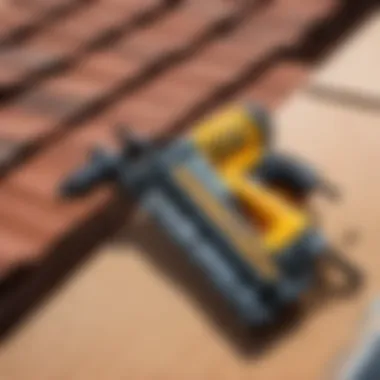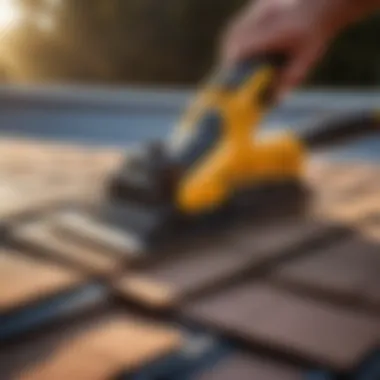Materials:
To successfully replace shingles on your roof, you will need the following materials:
- Asphalt shingles (ensure you have enough to cover the damaged area)
- Roofing nails (galvanized to prevent rust)
- Roofing adhesive or cement
- Plywood sheets (if replacement of the roof deck is necessary)
- Roofing felt or underlayment
- Drip edge
- Ventilation materials
DIY Steps:
Follow these detailed instructions for a seamless shingle replacement project:
- Safety First: Begin by ensuring a safe working environment, using proper protective gear.
- Assessment: Inspect the roof for damaged or missing shingles to determine the extent of the repair needed.
- Preparation: Clear the area around the damaged shingles, removing any debris or obstacles.
- Removing Old Shingles: Carefully lift and remove damaged shingles, taking care not to damage surrounding ones.
- Roof Deck Inspection: Check the roof deck for any signs of damage or rot that may require repair.
- Replacement Shingles: Install new shingles starting from the bottom row, overlapping as per manufacturer instructions.
Technical Aspects:
For a successful shingle replacement project, make sure to have the following tools and adhere to these critical techniques:
- Roofing hammer or nail gun
- Utility knife
- Ladder
- Caulking gun
- Proper temperature and weather conditions for installation
- Nail placement and spacing guidelines for secure installation
DIY Project Process:


Follow these sequential steps for a professional shingle replacement process:
- Installing New Shingles: Ensure proper alignment and secure fastening of new shingles, working from bottom to top.
- Sealing Edges: Apply roofing adhesive or cement to seal the edges and prevent water leakage.
- Inspecting Work: Step back and inspect the installation for any gaps or loose shingles that may need adjustment.
Troubleshooting Tips:


In case of common mistakes or adjustments needed during the shingle replacement process, consider the following tips:
- If shingles overlap incorrectly, gently lift and readjust for proper alignment.
- Check for any exposed nails that may need to be secured to prevent water infiltration.
- Utilize roofing adhesive or cement to seal any gaps between shingles for added protection.
Introduction


Replacing shingles on your roof is a crucial aspect of home maintenance that ensures the longevity and structural integrity of your property. This comprehensive guide aims to equip housewives and homeowners with the necessary knowledge and skills to effectively undertake this task. Understanding the ins and outs of shingle replacement not only enhances your property's curb appeal but also protects it against potential damage from environmental elements. By following the detailed steps outlined in this article, you can proactively maintain your roof, ultimately saving on costly repairs in the long run.
In this introductory section, we delve into the significance of replacing shingles, emphasizing the preventive and aesthetic benefits it offers. By assessing the condition of your roof and identifying areas in need of attention, you can address issues promptly, prolonging the lifespan of your roof. Additionally, we explore the considerations and preparations required before diving into the shingle replacement process. By familiarizing yourself with the necessary materials and tools, you can streamline the replacement procedure and ensure a seamless execution.
Stay tuned as we guide you through each step of the shingle replacement process, from assessing the damage to finishing touches and inspection. Through meticulous attention to detail and adherence to best practices, you can transform your roof, enhancing both its appearance and functionality. Get ready to embark on this home improvement journey, gaining valuable insights and skills along the way.
Assessing the Damage
When it comes to replacing shingles on your roof, the initial step of assessing the damage plays a crucial role in ensuring the success and longevity of the repair work. By meticulously evaluating the condition of your roof, you can pinpoint areas that require attention, prevent further issues, and ultimately maintain the structural integrity of your home.
Inspecting the Roof
Check for Loose Shingles
- When inspecting your roof, checking for loose shingles is paramount. Loose shingles can be a telltale sign of potential water seepage or wind damage, making them a key focus during the assessment. Their presence could indicate underlying issues that need to be addressed promptly to avoid escalation.
Look for Signs of Wear and Tear
- Looking for signs of wear and tear is essential in the assessment process. It involves examining the overall condition of the shingles, such as cracks, curling, or missing granules. These indicators can signify age-related deterioration or weather damage, guiding you on which areas need immediate replacement.
Gathering Materials and Tools
List of Necessary Supplies
- Having a comprehensive list of necessary supplies ensures you are equipped to handle the shingle replacement effectively. From shingles and underlayment to roofing nails and sealant, each item plays a vital role in the repair process. By preparing in advance, you can streamline the workflow and avoid unnecessary delays.
Required Tools for the Job
- The right tools are instrumental in achieving a professional outcome when replacing shingles. Items like a roofing hammer, utility knife, and chalk line are essential for precision and efficiency. Understanding the purpose of each tool and how to use it correctly enhances the overall quality of the repair work.
Preparing the Work Area
When it comes to replacing shingles on your roof, preparing the work area is a crucial step that sets the foundation for the entire project. This section focuses on ensuring that the environment in which you'll be working is safe, organized, and primed for efficiency. By taking the time to prep the work area correctly, you can streamline the process and minimize potential risks and obstacles.
In this article, we emphasize the significance of preparing the work area as it influences the overall success of your shingle replacement endeavor. Whether you're a seasoned DIY enthusiast or a beginner tackling home maintenance, laying the groundwork by setting up a well-prepped work area is essential.
Ensuring Safety Measures
Use of Protective Gear
The use of protective gear cannot be overstated when engaging in roof maintenance tasks like shingle replacement. From durable work gloves to sturdy boots and protective eyewear, each piece of gear plays a vital role in safeguarding you from potential hazards. In this article, we stress the importance of investing in high-quality protective gear to shield yourself from sharp edges, debris, and other safety risks.
Selecting the right protective gear can significantly enhance your safety and comfort during the project. By prioritizing safety in every aspect of the job, including the gear you wear, you not only reduce the likelihood of accidents but also boost your confidence and efficiency while working on the roof.
Securing the Ladder
Securing the ladder properly is another key aspect of ensuring safety during roof maintenance tasks. A stable and correctly positioned ladder is vital for accessing different areas of the roof without the risk of falls or injuries. In this section, we highlight the techniques and tools needed to secure the ladder effectively before ascending to the roof.
Mastering the art of ladder safety is fundamental to the success of your shingle replacement project. By following best practices for ladder placement and securing methods, you mitigate the dangers associated with working at heights and ensure a stable platform for executing tasks with precision and confidence.
Clearing Debris
Clearing debris from the work area is a critical step in preparing your roof for shingle replacement. This phase involves removing old, damaged shingles and cleaning the roof surface to create a clean and level foundation for the new shingles. By eliminating debris, you enhance the adherence and longevity of the replacement shingles while minimizing the risk of issues arising from underlying damage.
In this article, we delve into the importance of thorough debris clearance and provide insights into efficient techniques for removing old shingles without causing further harm to the roof structure. Additionally, we emphasize the significance of cleaning the roof surface to ensure optimal conditions for the installation of the new shingles.
Removing Old Shingles
The process of removing old shingles is a critical component of the preparation phase for shingle replacement. By carefully detaching worn-out shingles and disposing of them appropriately, you pave the way for installing the new shingles seamlessly. In this section, we elaborate on the methods and tools required to remove old shingles effectively while minimizing disruptions to the roof's integrity.
Cleaning the Roof Surface
Cleaning the roof surface is a meticulous task that involves removing dirt, debris, and residue to promote proper adhesion of the new shingles. A clean surface not only enhances the aesthetic appeal of your roof but also ensures a secure bond between the shingles and the roof structure. In this segment, we underscore the importance of thorough roof surface cleaning and offer practical tips for achieving a pristine surface ready for shingle installation.
Removing and Replacing Shingles
In this section of the article, we will delve into the critical process of removing and replacing shingles on your roof. This stage is vital in rejuvenating the integrity and longevity of your roof, ensuring it remains a robust shield for your home against the elements. By understanding the specific elements, benefits, and considerations related to this task, you will be equipped to carry it out effectively and efficiently.
Lifting the Damaged Shingles
When it comes to lifting the damaged shingles, precision and care are paramount. The technique for safely lifting shingles plays a pivotal role in the overall success of the roof replacement process. By implementing proper techniques, you not only protect the underlying structure of the roof but also maintain the aesthetic appeal of your home. Ensuring that the shingles are lifted safely mitigates the risk of causing further damage, saving you time and resources in the long run.
Techniques for Safely Lifting Shingles
One of the key aspects of safely lifting shingles is the method used to avoid unnecessary harm to the roof. By employing gentle yet effective techniques, such as sliding a flat bar underneath the shingle tabs, you can elevate the damaged shingles without causing additional stress to the surrounding area. This technique is popular for its ability to delicately lift shingles without compromising their integrity, making it a preferred choice for this task. Its unique feature lies in its gentle but firm approach, safeguarding the shingles from unnecessary wear and tear while facilitating a seamless removal process.
Avoiding Further Damage
Another crucial consideration when lifting damaged shingles is avoiding further damage to the roof structure. By being mindful of the surrounding shingles and the underlying layers, you can prevent accidental harm during the lifting process. Vigilance in maintaining the roof's condition while lifting shingles is essential to prevent any costly repercussions down the line. The technique of avoiding further damage emphasizes a meticulous approach to ensure that the roof remains intact and secure throughout the replacement procedure, providing long-term advantages while minimizing potential drawbacks.
Installing New Shingles
Once the damaged shingles are lifted, the next step is to proceed with installing new shingles. Proper placement and alignment are key factors in this stage, as they contribute significantly to the overall effectiveness and longevity of the roof replacement.
Proper Placement and Alignment
The proper placement and alignment of new shingles are crucial for the structural integrity and aesthetic appeal of your roof. By positioning the shingles accurately and aligning them neatly along the roof slope, you can create a seamless and robust covering that enhances the overall functionality of the roof. This approach is popular for its ability to ensure a tight seal and optimal coverage, making it a beneficial choice for this article. Its unique feature lies in its attention to detail, guaranteeing a meticulous installation process that minimizes the risk of future issues.
Securing Shingles in Place
Securing the newly installed shingles in place is the final step to fortifying your roof against external elements. By utilizing proper fastening techniques and materials, you can prevent dislodgment and ensure the longevity of the roof's protective layer. The process of securing shingles emphasizes the importance of stability and endurance, providing a secure foundation for your roof to withstand various weather conditions. Its unique feature lies in its ability to reinforce the roof structure and enhance its durability, offering long-term advantages while mitigating potential disadvantages.
Finishing Touches and Inspection
In the well-rounded process of replacing shingles on your roof, the Finishing Touches and Inspection stage holds paramount significance. This pivotal phase not only ensures the visual appeal of your roof but also guarantees its long-term durability and functionality. By meticulously attending to the final details and conducting a thorough inspection, you can rest assured that your roofing project is completed to the highest standards.
When we delve into the core elements of Finishing Touches and Inspection, we encounter two key aspects that demand attention: Sealing the Edges and Final Inspection. These components play a crucial role in enhancing the overall quality of the roof replacement project.
Sealing the Edges
Applying Roof Sealant
Applying roof sealant is a critical step in sealing the edges of the shingles, which serves as a protective barrier against moisture, UV rays, and other external elements. The application of roof sealant not only enhances the weather resistance of the roof but also extends the lifespan of the shingles. Its seamless integration ensures a watertight seal, preventing water infiltration and potential leaks. Roof sealant acts as a safeguard, promoting the structural integrity of the roof and contributing to its overall resilience.
Ensuring Proper Adhesion
Ensuring proper adhesion is vital in securing the shingles in place and promoting their longevity. Proper adhesion prevents uplift and shifting of the shingles, especially under harsh weather conditions. By adhering the shingles correctly, you eliminate the risk of premature deterioration and displacement. This meticulous process guarantees that the shingles remain steadfast, enhancing the durability and performance of the entire roofing system.
Final Inspection
Checking for Loose Nails
As part of the final inspection process, checking for loose nails is imperative to rectify any potential hazards and secure the structural stability of the roof. Loose nails can pose a risk of shingle displacement and create entry points for water intrusion. By diligently inspecting for loose nails and addressing any issues promptly, you preserve the integrity of the roofing system and prevent future complications.
Surveying the Roof for Completeness
Surveying the roof for completeness entails a comprehensive assessment of the entire roofing surface to ensure that all areas have been properly addressed and finished. This meticulous survey identifies any overlooked issues or areas that require additional attention. By conducting a thorough inspection, you guarantee that the roof replacement project is executed with precision and thoroughness, leaving no room for error.
In essence, the Finishing Touches and Inspection phase serves as the final seal of quality and assurance in your shingle replacement endeavor. By focusing on meticulous details and thorough examinations, you not only enhance the aesthetics of your roof but also fortify its structural integrity and longevity.
Conclusion
In the realm of home maintenance, the conclusion stage of replacing shingles on your roof holds immense significance as it signifies the final touch to the labor-intensive process. The meticulous attention to detail observed in sealing the edges and conducting a final inspection plays a crucial role in ensuring the longevity and effectiveness of the newly replaced shingles.
During the sealing process, the application of roof sealant is not merely a formality but a protective measure that guards against water infiltration, ultimately preventing leaks and water damage to the underlying structure of the roof. By meticulously applying the sealant along the edges of the shingles, one can bolster the roof's waterproofing capabilities, enhancing its resilience against the elements.
Moreover, the act of conducting a final inspection is equally vital in guaranteeing the successful execution of the shingle replacement project. By meticulously checking for loose nails and surveying the roof for any overlooked areas, one can rectify any potential issues before they escalate into larger problems. This final scrutiny epitomizes the commitment to excellence required in home maintenance tasks, ensuring that the roof is not only aesthetically pleasing but also structurally sound.
Furthermore, the satisfaction derived from a job well done during the conclusion phase is unparalleled. Taking a moment to admire the newly installed shingles shining under the sun's light can evoke a sense of accomplishment and pride in the homeowner. This emotional reward, coupled with the practical benefits of a well-maintained roof, makes the conclusion phase a fulfilling endpoint to the arduous but rewarding process of shingle replacement.
In essence, the conclusion phase of replacing shingles on your roof encapsulates the blend of meticulous craftsmanship, attention to detail, and the gratification of a job completed to high standards. It underscores the care and dedication required in home maintenance tasks and paves the way for a secure and appealing roof that can withstand the test of time.





